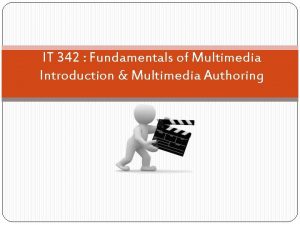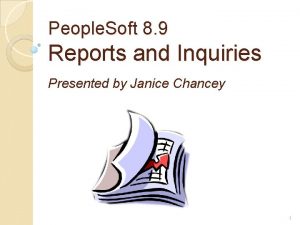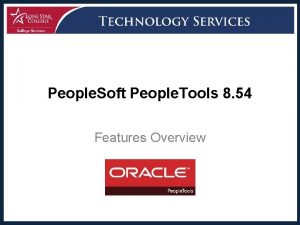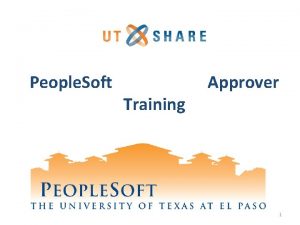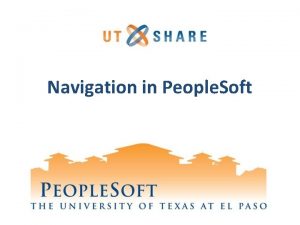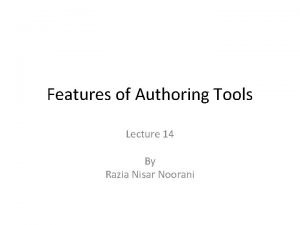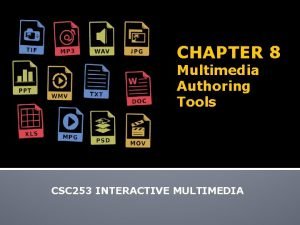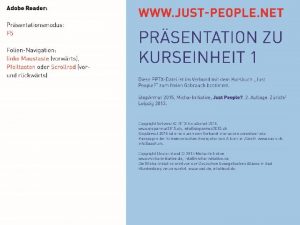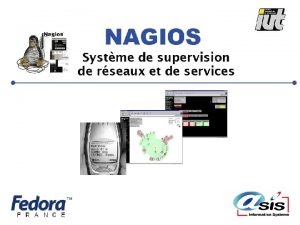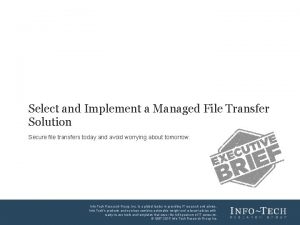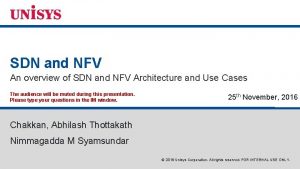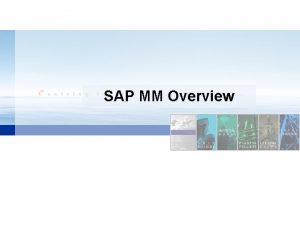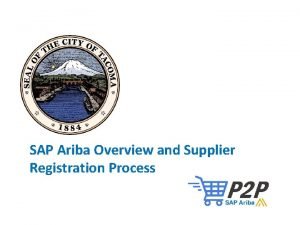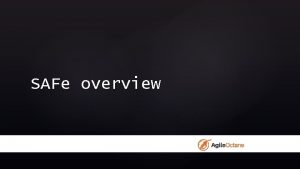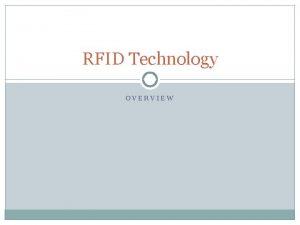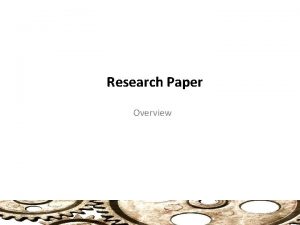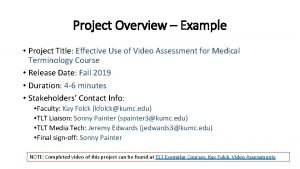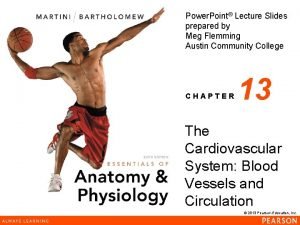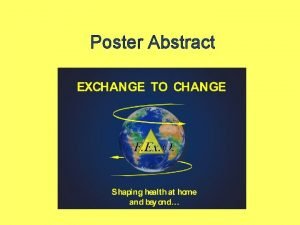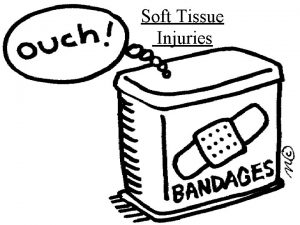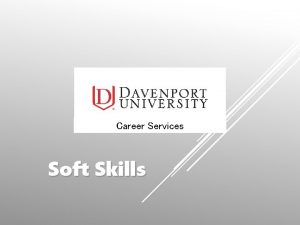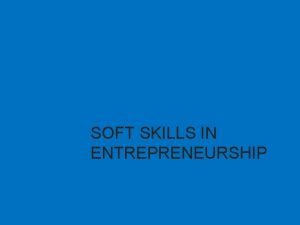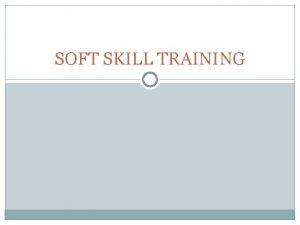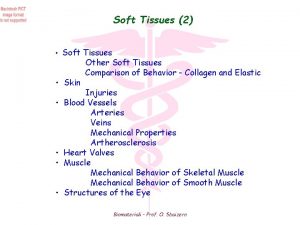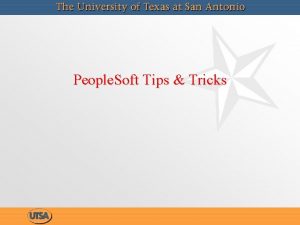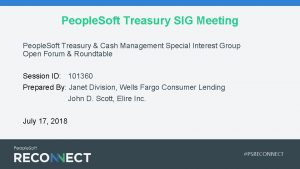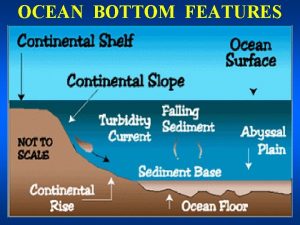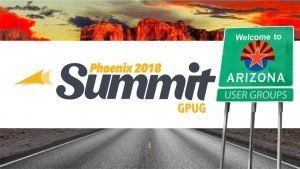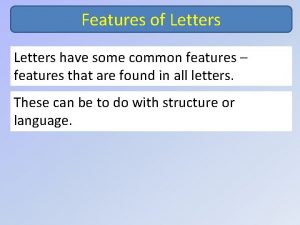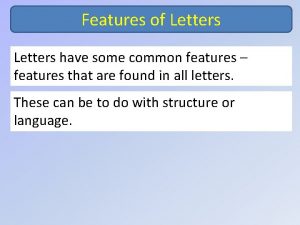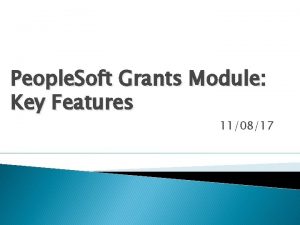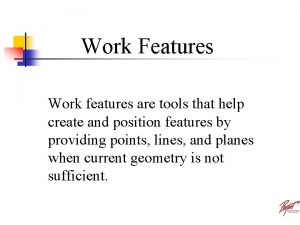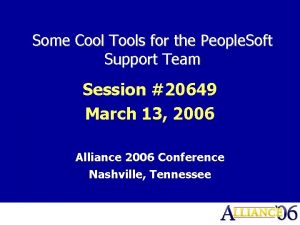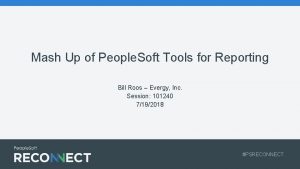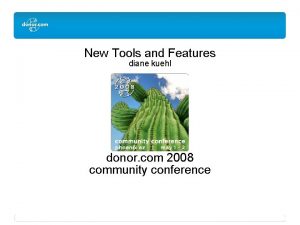People Soft People Tools 8 54 Features Overview




































- Slides: 36

People. Soft People. Tools 8. 54 Features Overview

People. Tools Overview People. Tools provides the underlying technology for People. Soft applications. All People. Soft applications, such as Human Capital Management and Customer Relationship Management are built, deployed, and maintained using People. Tools. With People. Tools you can: • Develop new applications or customize existing applications. • Administer applications that you have deployed within your organization. • Provide decision support and reporting functionality to decision makers. • Integrate People. Soft applications with other People. Soft applications or third party applications. • Upgrade and update your applications as part of system lifecycle management. • The area of People. Tools technology contains over 40 tools, utilities, and technologies. This document provides brief introductions of each tool or technology, and presents two frameworks with which you can gain a better understanding of the delivered technology, how to categorize the tools, and when to use particular tools.

People. Tools 8. 54 Categories Development Tools Reporting and Analysis Tools Integration Tools Administration Tools Lifecycle Management Tools

Development Tools • Application Engine is designed to help you develop, test, and run background SQL processing programs. • Global Technology Oracle's People. Soft applications are functionally equipped for implementation in global enterprises. • Fluid User Interface Developer’s Guide The People. Soft Fluid User Interface is designed to be a significant enhancement to the People. Soft’s “classic” user interface, which has been the interface display on browsers for People. Soft end users for well over a decade. The People. Soft Fluid User Interface moves away from pixel-perfect page layout and provides greater flexibility with the enhanced use of cascading style sheets (CSS 3), HTML 5, and Java. Script (if needed). (see example) • People. Code API Reference Contains information about certain application classes delivered with Oracle's People. Tools, as well as specifics about each class's methods and properties. • People. Code Developer’s Guide People. Code is the proprietary language used by People. Soft applications.

Development Tools • People. Code Language Reference Contains information about People. Code built-in functions, meta-SQL, system variables, and meta-HTML. • Application Designer Developer’s Guide People. Soft Application Designer is the core development tool used to build and modify People. Soft applications. • Documents Technology People. Soft documents technology includes a Document Builder, a People. Code API, and several utilities that enable you to create, manage, and test documents. • Optimization Framework People. Soft Optimization Framework provides a foundation for building applications that use the optimization-based, decision-making capability in the People. Tools environment. • Search Technology The People. Soft Search Framework provides a standard, declarative method for creating, deploying, and maintaining search indexes for all of your People. Soft applications.

Development Tools • Mobile Application Platform The People. Soft Mobile Application Platform (MAP) is a framework for building mobile applications. • Portal Technology In People. Tools, portal technology consists of People. Soft Pure Internet Architecture and the various systems, code, and standards used for creating and managing portals.

Reporting and Analysis Tools • Analytic Calculation Engine comprises a calculation engine plus several People. Tools features that enable application developers to define both the calculation rules and the display of calculated data within People. Soft applications for the purposes of multidimensional reporting, data editing, and analysis. • BI Publisher for People. Soft Oracle Business Intelligence Publisher (BI Publisher, formerly XML Publisher) is an enterprise reporting solution that streamlines report and form generation. (see example) • Crystal Reports for People. Soft enables you to generate both standard and custom-printed reports containing data from your People. Soft applications. (see example) • PS/n. Vision retrieves information from your People. Soft database and places it into a Microsoft Excel spreadsheet, in a form that helps you see the big picture, explore details, and make decisions. You use familiar Excel commands to format and analyze the data. With PS/n. Vision, you spend your time analyzing results rather than summarizing data and entering it into a spreadsheet. (see example)

Reporting and Analysis Tools • Cube Builder People. Soft Cube Builder is an extract-transform and load (ETL) application that enables you to use People. Soft Query and People. Soft Tree Manager to build Essbase applications and online analytical processing (OLAP) databases. (see example). • Pivot Grid People. Soft Pivot Grid supports operational dashboard reporting within the People. Tools framework to provide a pivot table and chart representation of data using PSQuery and component data source. The framework also enables you to see different views of the data, as in a Microsoft Excel pivot table, and the same data is also available in a chart view. (see example). • Process Scheduler People. Soft Process Scheduler is a centralized tool that enables application developers, system administrators, and application users to manage People. Soft batch processes. (see example) • Query People. Soft Query is an end user reporting tool. With People. Soft Query, you can extract the precise information that you are looking for by using visual representations of your People. Soft database, without writing SQL statements. (see example). • Tree Manager People. Soft Tree Manager, the People. Tools feature you use to create and maintain hierarchical relationships, such as trees. With People. Soft Tree Manager, you represent data graphically to show a hierarchy. (see example).

Reporting and Analysis Tools • Reporting Web Services A web service provides external applications a web-services-based means of accessing People. Soft data. Web services are implemented through the People. Tools Integration Broker (IB) framework. The Integration Gateway web application receives all the web service requests and forwards them to the Integration Engine (application server) for processing. (see example). • SQR Language Reference for People. Soft SQR for People. Soft is a powerful enterprise reporting system that provides direct access to multiple data sources. The SQR for People. Soft tools enables you to create clear, professional reports from complex arrays of information systems. • SQR for People. Soft Developers SQR for People. Soft is both a language and a set of tools that enables you to create professional reports.

Integration Tools • Feed Publishing Framework The Feed Publishing Framework provides user interfaces and application programming interfaces (APIs) for feed definition creation and maintenance, feed searching and subscription, as well as feed document generation and delivery. (see example). • Integration Broker Service Operations Monitor The Integration Broker Service Operations Monitor provides the following features: 1) Status on queues, nodes, and individual service operations. 2) You can also view and edit service operation XML. 3) Control and administration of domains that have publication and subscription (pub/sub) servers running against the current database. 4) Ability to activate or deactivate domains, recover from stalls, and so forth. 5) Workflow notification of error messages and archival of service operations. 6) Batch processes for error notification and service operation archival. • Integration Broker Testing Utilities and Tools The Integration Testing Utilities and Tools provides Send Master utility, Simple Post utility, Integration point test automation tools, Handler Tester utility, Transformation Test utility, Schema Tester utility, Generate SOAP Template utility, Service Operation Testing utility and Provider REST Template utility.

Integration Tools • Component Interfaces A component interface is a set of application programming interfaces (APIs) that you can use to access and modify People. Soft database information programmatically. • Integration Broker People. Soft Integration Broker performs asynchronous and synchronous messaging among internal systems and thirdparty systems, exposes People. Soft business logic as web services to People. Soft and third-party systems, and consumes and invoke web services from third-party and People. Soft systems. • Integration Broker Administration performs system administration tasks in People. Soft Integration Broker such as: • Set up and configure integration system components, such as messaging servers, nodes, integration gateways, listening and target connectors, and so on. • Configure the integration system to handle services, including specifying namespaces, setting up UDDI repositories, and so on. • Secure the integration environment by applying security at the web server, gateway, application server, node and service operation level. • Fine tune integration system performance by employing failover, master/slave processing, load balancing, and so on. • And more. • Multi. Channel Framework People. Soft Multi. Channel Framework (MCF) provides the tools that are required to support multiple channels of communication between customers (users) and agents. Some People. Soft applications, such as an email response management system (ERMS) from People. Soft CRM, use People. Soft Multi. Channel Framework or you can develop your own applications on the framework that is provided.

Integration Tools • Supported Integration Technologies EDI Manager, Outgoing Forms API and Open Query ODBC Driver and API. • Workflow Technology Workflow capabilities enable you to efficiently automate the flow of information throughout your enterprise, crossing both application and functional boundaries. People. Soft Workflow Technology consists of a powerful set of tools that enables you to automate time-consuming business processes and deliver the right information to the right people at the right time. You can merge the activities of multiple users into flexible business processes to increase efficiency, cut costs, and keep up with rapidly changing customer and competitive challenges.

Administration Tools • Automated Configuration Management With each new release, Oracle People. Tools provides new technology to our infrastructure, which adds rich, new features to support the functional requirements of our applications. While the new technology enhances the user experience and capabilities of our applications, the new technology often brings additional steps to the environment configuration and implementation process. This can create challenges for system administrators, development teams, and testing teams who routinely set up numerous environments that need to be refreshed on a regular basis. Oracle People. Tools and People. Soft application teams share that same challenge. • Data Management People. Soft Data Mover, People. Soft Data Archive Manager, Data integrity and auditing, Diagnostics Framework and Database platform considerations. • Performance Monitor The Performance Monitor enables you to view real-time and historical performance data of your People. Soft systems. The Performance Monitor provides the information that you need to solve immediate performance issues and analyze trends in system performance. • Security Administration User security, Lightweight Directory Access Protocol (LDAP), authentication and single signon, data encryption, query and definition security and People. Soft personalizations.

Administration Tools • System and Server Administration PSADMIN, analytic servers, web servers, verify search indexes, People. Soft Configuration Manager, People. Tools utilities, tracing and debugging, Jolt Internet Relay and timeout settings.

Lifecycle Management Tools • Change Assistant and Update Manager Oracle's People. Soft Change Assistant is a standalone, Windows based, Java program that orchestrates the process of updating or upgrading your People. Soft system. • Application Designer Lifecycle Management Guide • Change Impact Analyzer is a tool installed separately from People. Soft People. Tools that helps you determine the impact of specific changes you plan to make during an application upgrade. It's an interactive program where you can see the relationships of People. Soft definitions in a hierarchical view. • Setup Manager is a tool that helps you implement People. Soft applications by using a project and predefined tasks to produce a setup task list that is specific to your implementation project.

Lifecycle Management Tools • People. Soft Test Framework (PTF) PTF automates various tasks within the People. Soft application, primarily functional testing. Automating functional testing enables testers to execute more tests with greater accuracy during a shorter time. • Data Migration Workbench facilitates the Configuration Management process using Application Data Sets (ADS) as its underlying transport technology.

Functional Updates • Activity Management “Marks and Exams” describes a comprehensive design for calculating results within a course structure. Institutions require granular grading structures and calculation functionality to evaluate a variety of student assignments, attendance and course level examinations. The registry connects to course catalog entries and allows users to define a course calculation structure in a hierarchical design (content tree) where detailed grading rules can be defined. The next step is to carry that structure to the schedule level and allow administrative users to manage and organize class content. (see example). • Evaluation Management System The Evaluation Management System feature is not tied to a singular module within Campus Solutions (for example, Application Evaluations); it is intended to create a ‘generic’ evaluation solution which can be leveraged across Campus Solutions, including people, organizations, and departments or faculties. The feature is flexible enough that it can support many different models of an evaluation review. It provides institutions with the ability to determine what will be evaluated (for example, Admissions Application), who will evaluate it (such as evaluators and committees), and the ability to determine and configure the business process for the evaluation itself. The feature builds on the existing committee structures and provides an administrative evaluation structure where the evaluation process can be managed. ( see example). • Program Enrollment describes an educational model where a student must generally complete a strictly defined set of courses towards the completion of their academic objective in a specified sequence; each of which are often structured in a series of levels or stages, where one stage must be successfully completed before a student can progress and enroll in the next set of courses. (see example).

Functional Updates • Research Enrollment Tracking The Research Enrollment Tracking feature is intended to provide a complete set of operations for administrators to manage their graduate research candidates including: • Ability to capture and manage research related information in a single location in the Candidate Management component. This component brings together all of the key research related data for a student so that it can be used to track a student’s research progress to the point of thesis submission and result outcome. • Ability to manage and allocate both internal and external supervisors and link them to various research topics. • The ability to track and manage the Thesis Submission process in a single location using the Thesis Management administrative component. It provides institutions with the ability to view the details related to submission, progress, and final decisions. • Rules Engine The Rules Engine provides: • a non-programmer user interface to create complex business rules. • a secure way to retrieve data from the system in a logical manner, perform calculations and evaluations, and update data. • a way to use the Entity Registry, a familiar logical hierarchy, to retrieve data from the system; for example, the curriculum structure of the Academic Item Registry (AIR) or the results structure of the Academic Progress Tracker (APT). • System Variables and Functions for creating Rules. • a compiler (Rule Builder) that compiles and readies Rules for execution. • a means to manage changes to Rules over time and a large number of Rules using versioning.

Functional Updates • Student Activity Guides Activity guides are a People. Tools feature that allow you to define guided procedures for a user or group of users to complete. Users are presented with a list of actions, or tasks, that need to be completed to finish the procedure. Activity guides can be useful in a number of procedural scenarios. For example: • The on-boarding of a new employee. • Benefits enrollment. • A life change event, such as a marriage or the birth of a child. • Period end closing. • System or feature configuration. An activity guide lists the tasks (referred to as action items) that need to be completed by a user or group of users. These tasks are linked to specific local or remote transactions or external URLs. The tasks can be assigned to a specific user by user ID or to a group of users by People. Tools role. Activity guides provide a hierarchical organization of dependent and sequential tasks.

Tools Exclusive and General Updates • Accessibility People. Tools provides the underlying technology for People. Soft applications. All People. Soft applications, such as Human Capital Management and Customer Relationship Management, are built, deployed, and maintained using People. Tools is designed to generate HTML content that is coded to standards to work with assistive technology. This HTML content includes several accessibility features to help people who use assistive technology, such as screen readers. People. Soft accessibility features include: • Alternate text for images, buttons, collapsible section icons, and hide and expand grid tabs. • Table summaries and row and column headings for tables. • The ability to add links and anchors that enable keyboard-only users to bypass repeated navigation content, such as page tabs. • The removal of icon links within a page and the removal of page links from the bottom of pages to reduce redundancy when using screen reader software. • A feature that presents the elements on the body of a page in a linear format (recommended for blind users who use assistive technology, such as screen readers). • Landmarks that identify page sections. These landmarks provide a method to programmatically identify web page sections in a consistent way, which enables assistive technologies to provide users with features they can use to identify and navigate to sections of page content. • Application Designer To align with design standards, for People. Tools 8. 53, pages created with Application Designer will have right aligned field labels. These field labels will be left positioned with no colon display. This feature greatly streamlines the otherwise manual process of field label alignment. Once a field is placed on a page, the developer retains the ability to change the label alignment default in Application Designer where necessary by changing the Align Field Labels checkbox in People. Tools Options page.

Tools Exclusive and General Updates • Application Engine People. Tools 8. 54 will include enhancements to streamline Application Engine Trace files. • User Experience Design A new style sheet makes all aspects of a People. Soft application more contemporary and visually pleasing. The new style sheet affects not only colors, but homepages, headers, application pages, and pagelets. Page controls and other design elements are also updated.

Vision TO BE THE INNOVATION & SERVICE EXCELLENCE LEADER IN HIGHER EDUCATION Visit us at Lone. Star. edu/OTS

return to slide show

return to slide show

return to slide show

return to slide show

return to slide show

return to slide show

return to slide show

return to slide show

return to slide show

return to slide show

return to slide show

return to slide show

return to slide show

return to slide show
 Overview of multimedia software tools
Overview of multimedia software tools People soft 8
People soft 8 People soft
People soft Peoplesoft utep
Peoplesoft utep Paycheck
Paycheck Features of authoring tools
Features of authoring tools Multimedia authoring software
Multimedia authoring software Marking tools in sewing
Marking tools in sewing Independent blogger people as media
Independent blogger people as media In the usa the big cia
In the usa the big cia Transformed people transform people
Transformed people transform people People just people
People just people Www stands for world wide web
Www stands for world wide web Maximo overview
Maximo overview Universal modeling language
Universal modeling language Uml
Uml Vertical retail
Vertical retail Figure 12-1 provides an overview of the lymphatic vessels
Figure 12-1 provides an overview of the lymphatic vessels Systemic circulation flow chart
Systemic circulation flow chart Texas public school finance overview
Texas public school finance overview Walmart operations
Walmart operations Stylistic overview of architecture
Stylistic overview of architecture Jackson structured design
Jackson structured design Spring framework overview
Spring framework overview Nagios tactical overview
Nagios tactical overview Market overview managed file transfer solutions
Market overview managed file transfer solutions Sdn vs nfv
Sdn vs nfv Sbic program
Sbic program Sap mm overview
Sap mm overview Ariba overview
Ariba overview Safe overview
Safe overview Rfid technology overview
Rfid technology overview Sots meaning in research
Sots meaning in research Perbedaan replikasi virus dna dan rna
Perbedaan replikasi virus dna dan rna Example of a project title
Example of a project title Venous drainage of the abdomen
Venous drainage of the abdomen Abstract overview
Abstract overview
